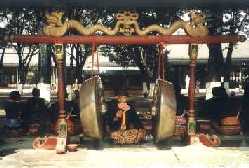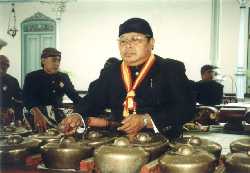Fusion |
|
INTRODUCTION TO JAVANESE GAMELAN |
|
|
|
There are many
forms of music, instruments and ensembles in Indonesia. Perhaps the most famous are the
bronze gong and xylophone ensembles known as Gamelan on the islands of Java and
Bali. While there are instrumental ensembles made of wood, bamboo and iron, bronze
represents the highest development and are highly prized as material as well as spiritual
objects in the classical palace traditions. For this introduction to Indonesian music, the focus will be on the classical palace or court traditions of Central Java. It is here that development flourished in the beginning of the 20th century. There are two court cities, Surakarta (also known as Solo) and Jogjakarta, each with two palaces, a higher and a lower one. In these four palaces, one finds the best gamelan sets, the best players, dancers and collections of sacred artifacts. Even though Indonesia has been a republic since 1945 and the palaces have no real political power, they still exist and continue to be spiritual power centers for the people. |
|
| The instruments of the Javanese gamelan can be
categorized as follows: (1) vertical hanging gongs of various sizes, (2) horizontally
suspended gongs (resembling upside-down kettles), (3) keyed instruments played with one or
with two mallets, (4) drums, (5) a two-stringed fiddle, (6) a bamboo flute, (7) a stringed
zither. In addition, there are female solo vocalists and a male chorus. Each gamelan actually comprises two complete sets of instruments, one in each of the two tunings of Slendro and Pelog. Slendro resembles roughly the raga Mohanam (or Hindustani Bhoopali) and Pelog resembles Gambheeranata. Each player sits between two instruments and switches positions depending on the composition being played. |
Typical Javanese Gong |
Kettle-Gongs - Bonang |
Gamelan music allows for improvisation by some
of the instruments (bronze xylophone gender played with two mallets, the rebab
fiddle, the suling flute, the wooden xylophone, gambang), the female
vocalist (pesindhen) and the two-headed kendhang (resembling somewhat
the mridangam or more likely, the pakhwaj). The improvisations are based on a basic melody
called the balungan (literally, bones) played usually on every beat by the keyed
instruments using one mallet (slenthem, demung, saron, saron panerus). This balungan
is also embellished by the double-rowed horizontally suspended kettle-gongs called bonang
and the one-octave higher bonang panerus. The result is multiple layers of sounds interacting with each other - one leading, sometimes following and everyone coming to agreement on the final gong note of the balungan. |
The balungan
is structured over a regular series of beats (multiples of 8, 16, 32, 64, 128, and even
256) in a cycle. The end of the cycle is marked by the biggest hanging gong. The gong
cycle is subdivided either by two or four, marked by the big horizontally suspended
kettle-gongs called kenong. The medium-sized hanging gongs called kempul
mark the middle of those subdivisions, depending on the particular form. In between the kempuls
and kenongs, there is a possible further subdivision marked by the small
horizontally suspended kethuk. This whole time-structure is called the colotomic
structure and is the basis of all gamelan music. The oldest and most revered classical
pieces usually have the longest gong cycles (128 or 256 beats). …T …. …T …K where T is the ketuk, K is the kenong,
and G is the gong (kempul is not used in this form). Alex Dea |
|
| Note: The author is an ethnomusicologist with a fine understanding of different music systems across the world. | |
| Fusion home | |
| Western music | |

